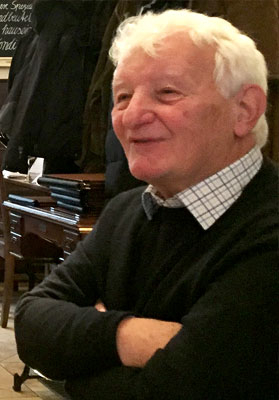Josef Riederer, one of the most eminent heritage scientists of his generation, passed away on 3 June following a brief illness.
Having graduated in geology from Ludwig-Maximilians Universität in Munich in 1962, Riederer obtained his PhD two years later. He began his work in the field of cultural heritage conservation in 1967 at the Doerner Institute with the Bayerische Staatsgemäldesammlung (Bavarian State Painting Collections) in Munich.
In 1973, Riederer was given the enormous task of revitalizing the world’s first and oldest conservation science laboratory at the National Museums in Berlin. This laboratory was established in 1888 but had fallen into disarray after the Second World War. A generous grant from the Stiftung Volkswagenwerk enabled the laboratory to carry out archaeometric research and so close the knowledge gap that had formed between the National Museums and similar institutions elsewhere.
Josef Riederer planed and implemented this new research entity, then known as the Rathgen Research Laboratory for the Prussian Cultural Heritage Foundation. He was nominated as its third Director in 1974, following the footsteps of Friedrich Rathgen, the first Director from 1888 to 1928, and of Carl Brittner, its second Director from 1928 to 1948.
During Riederer’s thirty-year tenure, he turned the laboratory into a global reference point for archaeometry and conservation science, despite the challenge of convincing an often-resistant administration of the potential and importance of the emerging discipline of heritage science.
Fundamental research in heritage science soon became Riederer’s passion, as demonstrated by his enormous body of work documented in hundreds of publications and monographs. Some of these are still standard compendia for teaching and learning in heritage science, such as Kunst und Chemie – das unersetzliche Bewahren (1977) and Archäologie und Chemie – Einblicke in die Vergangenheit (1987).
In 1981, Riederer became Adjunct Professor of Archaeometry at TU Berlin, a position which he held until retirement. As an academic, he was deeply engaged in supervising the next generation of cultural heritage experts. Nationally and internationally, many colleagues can trace their career back to a chapter at the Rathgen Research Laboratory, where Josef Riederer had for decades developed a record as an outstanding mentor and source of inspiration for heritage scientists. I happily include myself in this group.
Riederer also worked extensively abroad. His advice and collaboration was sought after in numerous German and European research projects, in specific conservation projects ranging from Sri Lanka and India to the Americas (e.g. Copan, Honduras). He engaged in research collaborations with collections such as the Harvard Art Museums or the J. Paul Getty Museum, primarily in his favorite field of metal alloy analysis and provenance studies. The Rathgen database of metal alloys of cultural artefacts, which he built up in continuation of Friedrich Rathgen’s earlier work, comprises almost 20,000 entries.
In 1996 Riederer was a participant in the ICCROM course on Architectural Heritage Management in Potsdam, Germany. He was also affiliated with the CETRA project: Concerted European Training and Research Actions supported by the European Union (September 1998 to June 1999), an initiative in which ICCROM participated through two of its former staff members, Marisa Laurenzi Tabasso and Rocco Mazzeo.
For many years Riederer acted as coordinator of the ICOM-CC Stone Committee, hosting the 8th International Conference on Deterioration and Conservation of Stone in Berlin in 1996. Thanks to his participation with the ICOM-CC, ICCROM had the pleasure of hosting him and many other colleagues at the ICOM-CC Working Group Representatives Meeting in 2000 in Rome.
Riederer’s name is further linked to authenticity discussions and revised attributions of prime objects in the Berlin collections. These include “The Man with the Golden Helmet,” formerly attributed to Rembrandt, and “Flora,” formerly attributed to Leonardo da Vinci. He consulted on the conservation of the Bronze Quadriga on the Brandenburg Gate, published groundbreaking studies on the mural painting technology along the ancient Silk Road, and made important technological discoveries on the famous bust of the Egyptian Queen Nefertiti.
With all his professional undertakings getting wide attention among peers and the broader public, Riederer also was deeply engaged in social issues, and made it a priority to host interns suffering from Asperger syndrome in the Rathgen Research Laboratory.
During the years of his retirement after 2005, Riederer kept close ties with the Rathgen Research Laboratory staff. He was a regular visitor, pursuing his research on ancient metals and reverse glass paintings. I will never forget our mission together to the Museum of Egyptian Antiquities in Cairo, where we were co-teaching a class in 2010 on the detection of fakes, forgeries and authenticity of cultural artefacts. We frequently met over a glass of our beloved Bavarian Weissbier, either in Berlin or in our Bavarian homeland, to talk shop and discuss the most recent trends of our field.
As his successor as Director of the Rathgen Research Laboratory, I couldn’t have imagined a better and more trustworthy predecessor, a more competent colleague, and a more encouraging friend over the years. Josef Riederer’s advice was priceless to me on innumerable occasions. His sudden and unexpected death, a huge loss for the German cultural heritage community, leaves an enormous void which we will not fill for a long time.
Stefan Simon, Yale University
Former ICCROM Council Member

